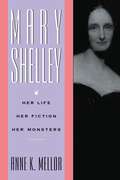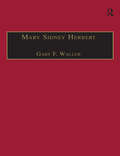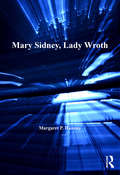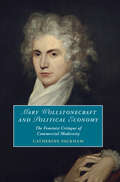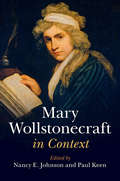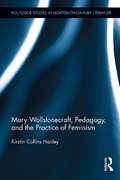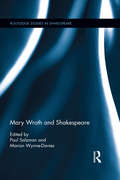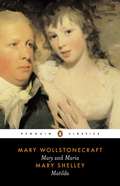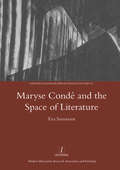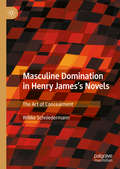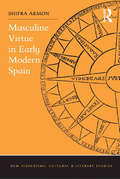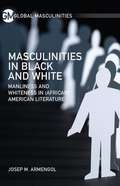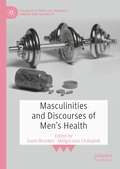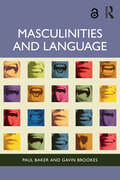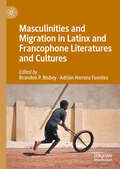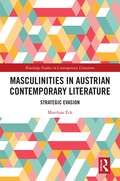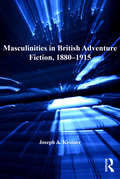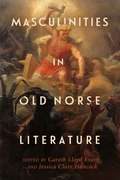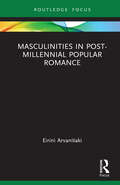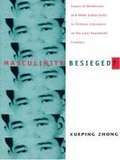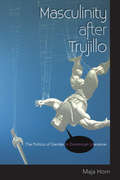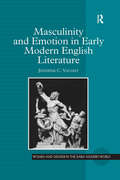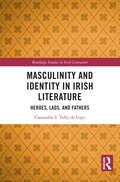- Table View
- List View
Mary Shelley: Her Life, Her Fiction, Her Monsters
by Anne K. MellorFirst published in 1990. Routledge is an imprint of Taylor & Francis, an informa company.
Mary Sidney Herbert: Printed Writings 1500–1640: Series 1, Part One, Volume 6 (The Early Modern Englishwoman: A Facsimile Library of Essential Works & Printed Writings, 1500-1640: Series I, Part One #Vol. 6)
by Gary F. WallerMary Sidney (1562-1620), Countess of Pembroke, was born into one of England’s most prominent literary and political families. She was fluent in at least three languages and was an accomplished translator and poet. Her two translations from the French, A Discourse of Life and Death, by Philippe de Mornay, and Antonius, a TragÅ“die, by Robert Garnier were published together in 1592 by William Ponsonby. That combined volume is reprinted here.
Mary Sidney, Lady Wroth
by Margaret P. HannayDespite her fascinating life and her importance as a writer, until now Lady Mary Wroth has never been the subject of a full-length biography. Margaret Hannay's reliance on primary sources results in some corrections, as well as additions, to our knowledge of Wroth's life, including Hannay's discovery of the career of her son William, the marriages of her daughter Katherine, her grandchildren, her last years, the date of her death, and the subsequent history of her manuscripts. This biography situates Lady Mary Wroth in her family and court context, emphasizing the growth of the writer's mind in the sections on her childhood and youth, with particular attention to her learned aunt, Mary Sidney Herbert, Countess of Pembroke, as literary mentor, and to her Continental connections, notably Louise de Coligny, Princess of Orange, and her stepson Prince Maurice. Subsequent chapters of the biography treat her experience at the court of Queen Anne, her relationships with parents and siblings, her love for her cousin William Herbert, her marriage to Robert Wroth, the birth and early death of her only legitimate child, her finances and properties, her natural children, her grandchildren, and her last years in the midst of England's civil wars. Throughout the biography attention is paid to the complex connections between Wroth's life and work. The narrative is enhanced with a chronology; family trees for the Sidneys and Wroths; a map of Essex, showing where Wroth lived; a chart of family alliances; portraits; and illustrations from her manuscripts.
Mary Wollstonecraft and Political Economy: The Feminist Critique of Commercial Modernity (Cambridge Studies in Romanticism)
by Catherine PackhamWhy was Wollstonecraft's landmark feminist work, the Vindication of the Rights of Woman, categorised as a work of political economy when it was first published? Taking this question as a starting point, Mary Wollstonecraft and Political Economy gives a compelling new account of Wollstonecraft as critic of the material, moral, social, and psychological conditions of commercial modernity. Offering thorough analysis of Wollstonecraft's major writings - including her two Vindications, her novels, her history of the French Revolution, and her travel writing - this is the only book-length study to situate Wollstonecraft in the context of the political economic thought of her time. It shows Wollstonecraft as an economic as much as a political radical, whose critique of the emerging economic orthodoxies of her time anticipates later Romantic thinkers. This title is part of the Flip it Open Programme and may also be available Open Access. Check our website Cambridge Core for details.
Mary Wollstonecraft in Context (Literature in Context)
by Paul Keen Nancy E. JohnsonMary Wollstonecraft (1759–1797) was one of the most influential and controversial women of her age. No writer, except perhaps her political foe, Edmund Burke, and her fellow reformer, Thomas Paine, inspired more intense reactions. In her brief literary career before her untimely death in 1797, Wollstonecraft achieved remarkable success in an unusually wide range of genres: from education tracts and political polemics, to novels and travel writing. Just as impressive as her expansive range was the profound evolution of her thinking in the decade when she flourished as an author. In this collection of essays, leading international scholars reveal the intricate biographical, critical, cultural, and historical context crucial for understanding Mary Wollstonecraft's oeuvre. Chapters on British radicalism and conservatism, French philosophes and English Dissenters, constitutional law and domestic law, sentimental literature, eighteenth-century periodicals and more elucidate Wollstonecraft's social and political thought, historical writings, moral tales for children, and novels.
Mary Wollstonecraft, Pedagogy, and the Practice of Feminism: Mary Wollstonecraft, Pedagogy, And The Practice Of Feminism (Routledge Studies in Eighteenth-Century Literature #9)
by Kirstin HanleyThis study examines Mary Wollstonecraft—generally recognized as the founder of the early feminist movement—by shedding light on her contributions to eighteenth-century instructional literature, and feminist pedagogy in particular. While contemporary scholars have extensively theorized Wollstonecraft’s philosophical and polemic work, little attention has been given to her understanding and representation of feminist practice, most clearly exemplified in her instructional writing. This study makes a significant contribution to the fields of both eighteenth-century and Romantic Era literature by looking at how early feminism influenced didactic traditions from the late-eighteenth century to today. Hanley argues that Wollstonecraft constructs a paradigm of feminist pedagogy both in the texts’ representations of teaching and learning, and her own authorial approach in re-appropriating earlier texts and textual traditions. Wollstonecraft’s appropriations of Locke, Rousseau, and other educationists allow her to develop reading and writing pedagogies that promote critical thinking and gesture toward contemporary composition theories and practices. Hanley underscores the significance of Wollstonecraft as teacher and mentor by revisiting texts that are generally assigned a short space in the context of a larger discussion about her life and/or writing, re-presenting her works of instruction as meaningful both in their revisionist approaches to tradition and their normative didactic features.
Mary Wroth and Shakespeare (Routledge Studies in Shakespeare)
by Paul Salzman Marion Wynne-DaviesOver the last twenty five years, scholarship on Early Modern women writers has produced editions and criticisms, both on various groups and individual authors. The work on Mary Wroth has been particularly impressive at integrating her poetry, prose and drama into the canon. This in turn has led to comparative studies that link Wroth to a number of male and female writers, including of course, William Shakespeare. At the same time no single volume has attempted a comprehensive comparative analysis. This book sets out to explore the ways in which Wroth negotiated the discourses that are embedded in the Shakespearean canon in order to develop an understanding of her oeuvre based, not on influence and imitation, but on difference, originality and innovation.
Mary and Maria, Matilda
by Mary Wollstonecraft Mary ShelleyThese three works of fiction - two by Mary Wollstonecraft, the radical author of A Vindication of the Rights of Woman, and one by her daughter Mary Shelley, creator of Frankenstein - are powerfully emotive stories that combine passion with forceful feminist argument. In Mary Wollstonecraft's Mary, the heroine flees her young husband in order to nurse her dearest friend, Ann, and finds genuine love, while Maria tells of a desperate young woman who seeks consolation in the arms of another man after the loss of her child. And Mary Shelley's Matilda - suppressed for over a century - tells the story of a woman alienated from society by the incestuous passion of her father. Humane, compassionate and highly controversial, these stories demonstrate the strongly original genius of their authors.
Maryse Conde and the Space of Literature
by Eva Sansavior"The Guadeloupean writer and critic Maryse Conde has for the last twenty-five years divided her time between her native Guadeloupe and the United States. If the author's work has attracted much critical attention in the United States, it is the fictional works that have been the focus of this attention with these predominantly read in the light of political themes such as identity and resistance. In these intelligent and sensitive readings, Eva Sansavior argues in favour of adopting a broader thematic and generic approach to the author's work. Sansavior accounts for the multiple and oblique uses of literature in the Conde's literary and critical work tracking its complex interactions with tradition, reception, politics and autobiography and also the singular possibilities that these interactions present for re-imagining the ideas of politics, literature, identity and, ultimately, the nature of critical practice itself."
Masculine Domination in Henry James's Novels: The Art of Concealment
by Wibke SchniedermannThis book proposes a new interdisciplinary approach to the gendered power relations in James’s novels. Reading James’s narrative form through the lens of relational sociology, specifically Pierre Bourdieu’s concept of symbolic domination, reconciles some of the most fiercely disputed positions in James studies of the past decades. The close readings focus on three novels, The Portrait of a Lady, The Wings of the Dove, and The Golden Bowl, providing a systematic relational analysis into the specifically Jamesian method of narrating the socio-psychological, embodied responses to masculine power and oppression. James persistently narrates his characters as social agents whose perception, affects, and bodily practices are products of the social structures that they in turn continue to shape and reproduce. The chapters trace a development throughout James’s career that reflects a growing sensitivity for the concealment and attendant misrecognition of gendered domination.
Masculine Ideals and Alexander the Great: An Exemplary Man in the Roman and Medieval World
by Jaakkojuhani PeltonenFrom premodern societies onward, humans have constructed and produced images of ideal masculinity to define the roles available for boys to grow into, and images for adult men to imitate. The figure of Alexander the Great has fascinated people both within and outside academia. As a historical character, military commander, cultural figure and representative of the male gender, Alexander’s popularity is beyond dispute. Almost from the moment of his death Alexander’s deeds have had a paradigmatic aspect: for over 2300 years he has been represented as a paragon of manhood - an example to be followed by other men - and through his myth people have negotiated assumptions about masculinity. This work breaks new ground by considering the ancient and medieval reception of Alexander the Great from a gender studies perspective. It explores the masculine ideals of the Greco-Roman and medieval past through the figure of Alexander the Great, analysing the gendered views of masculinities in those periods and relates them to the ways in which Alexander’s masculinity was presented. It does this by investigating Alexander’s appearance and its relation to definitions of masculinity, the way his childhood and adulthood are presented, his martial performance and skill, proper and improper sexual behaviour, and finally through his emotions and mental attributes. Masculine Ideals and Alexander the Great will appeal to students and scholars alike as well as to those more generally interested in the portrayal of masculinity and gender, particularly in relation to Alexander the Great and his image throughout history.
Masculine Virtue in Early Modern Spain (New Hispanisms: Cultural and Literary Studies)
by Shifra ArmonMasculine Virtue in Early Modern Spain extricates the history of masculinity in early modern Spain from the narrative of Spain’s fall from imperial power after 1640. This book culls genres as diverse as emblem books, poetry, drama, courtesy treatises and prose fiction, to restore the inception of courtiership at the Spanish Hapsburg court to the history of masculinity. Refuting the current conception that Spain’s political decline precipitated a ’crisis of masculinity’, Masculine Virtue maps changes in figurations of normative masculine conduct from 1500 to 1700. As Spain assumed the role of Europe’s first modern centralized empire, codes of masculine conduct changed to meet the demands of global rule. Viewed chronologically, Shifra Armon shows Spanish conduct literature to reveal three axes of transformation. The ideal subject (gendered male in both practice and law) became progressively more adaptable to changing circumstances, more intensely involved in currying his own public image, and more desirous of achieving renown. By bringing recent advances in gender theory to bear on normative rather than non-normative masculinities of early modern Spain, Armon is able to foreground the emergence of energizing new models of masculine virtue that continue to resonate today.
Masculinities In Black And White
by Josep M. ArmengolInverting the traditional focus of ethnic studies on blackness as the object of scrutiny, this book explores dominant forms of white masculinity as seen by African American authors placed alongside certain white writers. Author analyzes texts by Herman Melville, Ernest Hemingway, Martha Gellhorn, Frederick Douglass, and James Baldwin.
Masculinities and Discourses of Men's Health (Palgrave Studies in Language, Gender and Sexuality)
by Gavin Brookes Małgorzata ChałupnikThis book brings together a collection of case studies that explore the relationship between health and masculinity. It covers various topics related to health, such as mental health, sexual health, eating disorders and coronavirus, and offers health-based perspectives on issues such as migration and gender identity, as these relate to masculinities. In exploring these themes, this book addresses a wide range of communicative contexts, including online forums, interviews, advertising, sex education materials, migrant integration classes, and suicide notes. This book will appeal to linguists interested in health and gender (particularly masculinities), as well as scholars in fields such as psychology, media studies, cultural studies, and other humanities and social science disciplines with a focus on discourse.
Masculinities and Language
by Paul Baker Gavin BrookesToday, the topic of gender identity is being discussed more widely than ever before. With the rise of online misogyny and in the wake of #metoo, language around masculinity and toxic masculinity merits closer examination. Accessibly written by two leading linguists, this book provides a comprehensive treatment of the debates around language and masculinity, asking how language is used to perform masculinity and how language is used to represent men.Including examples of research from a range of international scholars, along with original case studies and engaging examples from popular culture, media, literature, advertising and politics, the authors address a wide range of theoretical and methodological standpoints. The book examines concepts of gender performativity, hegemonic masculinity and queer theory, drawing on disciplines and methods including conversation analysis, phonetics, ethnography, interviews, focus groups, visual analysis, discourse analysis, critical discourse studies and corpus linguistics. Situating male language use in terms of power, dominance and subordination, the book concludes with an examination of the more recent concepts of toxic masculinity and healthy masculinity, exploring critical stances towards and around language used by men.This book demonstrates the role that linguistic research can play in addressing real-world problems associated with masculinity – problems experienced by people of all genders and the natural world more broadly. Masculinities and Language is vital reading for scholars, researchers and students of language and gender, sexuality, identity, discourse analysis and sociolinguistics within linguistics, English language and related areas.The Open Access version of this book, available at http://www.taylorfrancis.com, has been made available under a Creative Commons Attribution-Non Commercial-No Derivatives (CC BY-NC-ND) 4.0 license.
Masculinities and Migration in Latinx and Francophone Literatures and Cultures
by Brandon P. Bisbey Adrián Herrera FuentesThis book adopts a transatlantic approach to consider literature and cultural products produced by authors confronted with the experience of migration, working from or looking in the direction of the Global North. It offers a comparative framework which underlines the differences and similarities between the Francophone and Latino American cultural spheres. The volume explores different aspects –gender identity, sexuality, violence – encountered in the intersectionality between masculinity and migration around the world. It also contextualizes this global phenomenon across two hemispheres, looking at colonial history, the role of migration, the predominant religion, racial identities, and levels of economic development. Chapters examine novels, short stories, TV, and other types of cultural production. Perspectives avoid as far as possible hierarchical, vertical and binomial configurations between self and other, North and South, male and female. ENDORSEMENTS A timely volume that invites us to explore how migration in the United States and Europe is changing our approach to masculinity studies. Its focus on migration and undesired migrants from the Global South, hegemonic masculinities, fashion, sports, hypersexualized virility, and masculinist performances offers new gender discussions in the context of Hispanic, Latinx, and Francophone literature and culture. Oswaldo Estrada, Professor of Spanish and Latin American Studies, University of North Carolina at Chapel Hill, US This is an urgently needed volume on one of the most central topics of our time: the book provides a transnational perspective on cultural representations of masculinity and migration. An essential read for scholars of Gender Studies, Migration and Comparative Literature. Gesine Müller, Professor of Romance Philology, University of Cologne, Germany
Masculinities and Representation: The Eroticized Male in Early Modern Italy and England
by Konrad EisenbichlerIn studies on premodern masculinities that have enriched scholarship in recent years, relatively little attention has been paid to the eroticizing of the male body. Masculinities and Representation seeks to fill this lacuna, illustrating how gender construction served to affirm but also diversify premodern masculinity. In so doing, this collection details how, as a social construct, masculinity was not a single concept, but a dynamic and intricate notion. Focusing on the premodern period, Masculinities and Representation reveals how heteronormative masculinity was affirmed, but also how it was challenged when the male body was eroticized in art, literature, and devotion, or when “masculine” norms were transgressed by the assumption of “feminine” behaviours. Ultimately, the book demonstrates how masculinity itself could be transgressive in its focus of affection or in its inherent ambiguities.
Masculinities in Austrian Contemporary Literature: Strategic Evasion (Routledge Studies in Contemporary Literature)
by Matthias EckMasculinities in Austrian Contemporary Literature: Strategic Evasion shows the important contribution that literature can make to the understanding of masculinities, by offering insights into the mental structures of hegemonic masculinity. It argues that while there is evidence of frustrating hegemonic masculinities, contemporary Austrian literature offers few positive images of alternative masculinity. The texts simultaneously criticize and present fantasies of hegemonic masculinity and as such provide a space for ambiguity and evasion. While providing readers with an in-depth study of the works of the authors Daniel Kehlmann, Doron Rabinovici and Arno Geiger, Matthias Eck elaborates the concept of strategic evasion. In order to bridge the gap between the ideal of masculinity and reality the male characters adopt two strategies of evasion: evasion to hide a softer and gentler side, and evasion into a world of fantasy where they pretend to live up to the ideal of hegemonic masculinity.
Masculinities in British Adventure Fiction, 1880–1915
by Joseph A. KestnerMaking use of recent masculinity theories, Joseph A. Kestner sheds new light on Victorian and Edwardian adventure fiction. Beginning with works published in the 1880s, when writers like H. Rider Haggard took inspiration from the First Boer War and the Zulu War, Kestner engages tales involving initiation and rites of passage, experiences with the non-Western Other, colonial contexts, and sexual encounters. Canonical authors such as R.L. Stevenson, Rudyard Kipling, Joseph Conrad, and Olive Schreiner are examined alongside popular writers like A.E.W. Mason, W.H. Hudson and John Buchan, providing an expansive picture of the crisis of masculinity that pervades adventure texts during the period.
Masculinities in Old Norse Literature (Studies In Old Norse Literature #4)
by Gareth Lloyd Evans Jessica Clare HancockCompared to other areas of medieval literature, the question of masculinity in Old Norse-Icelandic literature has been understudied. This is a neglect which this volume aims to rectify. The essays collected here introduce and analyse a spectrum of masculinities, from the sagas of Icelanders, contemporary sagas, kings' sagas, legendary sagas, chivalric sagas, bishops' sagas, and eddic and skaldic verse, producing a broad and multifaceted understanding of what it means to be masculine in Old Norse-Icelandic texts. A critical introduction places the essays in their scholarly context, providing the reader with a concise orientation in gender studies and the study of masculinities in Old Norse-Icelandic literature. This book's investigation of how masculinities are constructed and challenged within a unique literature is all the more vital in the current climate, in which Old Norse sources are weaponised to support far-right agendas and racist ideologies are intertwined with images of vikings as hypermasculine. This volume counters these troubling narratives of masculinity through explorations of Old Norse literature that demonstrate how masculinity is formed, how it is linked to violence and vulnerability, how it governs men's relationships, and how toxic models of masculinity may be challenged.
Masculinities in Post-Millennial Popular Romance (Routledge Focus on Literature)
by Eirini ArvanitakiThis book focuses on the projection of the hero’s masculinity in a selection of post-millennial popular romance narratives and attempts to discover if, and to what extent, this projection reinforces or challenges patriarchal ideas about gender. In the majority of these narratives the hero is often presented as a hegemonic alpha male. However, hegemonic masculinity is not a fixed concept. Rather, it is subject to continuous change which allows for the emergence of various dominant masculinities. Under a poststructuralist lens and through a close textual analysis approach and a gender reading of romance narratives, the book suggests that to a certain extent the romance hero could be described as a platform onto which different forms of dominant masculinity are displayed and highlights that these masculinities do not necessarily clash, depend on, or function as a prerequisite for each other.
Masculinity Besieged?: Issues of Modernity and Male Subjectivity in Chinese Literature of the Late Twentieth Century
by Xueping ZhongIn Masculinity Besieged? Xueping Zhong looks at Chinese literature and films produced during the 1980s to examine male subjectivities in contemporary China. Reading through a feminist psychoanalytic lens, Zhong argues that understanding the nature of male subjectivities as portrayed in literature and film is crucial to understanding China's ongoing quest for modernity. Before the 1990s onslaught of popular culture decentered the role of intellectuals within the nation, they had come to embody Chinese masculinity during the previous decade. The focus on masculinity in literature had become unprecedented in scale and the desire for "real men" began to permeate Chinese popular culture, making icons out of Rambo and Takakura Ken. Stories by Zhang Xianliang and Liu Heng portraying male anxiety about masculine sexuality are employed by Zhong to show how "marginal" males negotiate their sexual identities in relation to both women and the state. Looking at writers popular among not only the well-educated but also the working and middle classes, she discusses works by Han Shaogong, Yu Hua, and Wang Shuo and examines instances of self-loathing male voices, particularly as they are articulated in Mo Yan's well-known work Red Sorghum. In her last chapter Zhong examines "roots literature," which speaks of the desire to create strong men as a part of the effort to create a geopolitically strong Chinese nation. In an afterword, Zhong situates her study in the context of the 1990s. This book will be welcomed by scholars of Chinese cultural studies, as well as in literary and gender studies.
Masculinity after Trujillo: The Politics of Gender in Dominican Literature
by Maja Horn"Provides an insightful look at the persistent power of masculinism in Dominican post-dictatorship politics and literature."--Ignacio López-Calvo, author of God and Trujillo "The ideas about masculinization of power developed by Horn are important not only to Dominican scholarship but also to Caribbean and other Latin American students of the intersection of history, political power, and gendered practices and discourses."--Emilio Bejel, author of Gay Cuban Nation Any observer of Dominican political and literary discourse will quickly notice the prevalence of certain notions of hyper-masculinity. In this extraordinary work, Maja Horn argues that these gender conceptions became ingrained during the dictatorship (1930-1961) of Rafael Leonidas Trujillo, as well as through the U.S. military occupation that preceded it. Where previous studies have focused mainly on Spanish colonialism and the sharing of the island with Haiti, Horn emphasizes the underexamined and lasting influence of U.S. imperialism and how it prepared the terrain for Trujillo’s hyperbolic language of masculinity. She also demonstrates how later attempts to emasculate the image of Trujillo often reproduced the same masculinist ideology popularized by his government. Through the lens of gender politics, Horn enables readers to reconsider the ongoing legacy of the Trujillato, including the relatively weak social movements formed around racial and ethnic identities, sexuality, and even labor. She offers exciting new interpretations of such writers as Hilma Contreras, Rita Indiana Hernández, and Junot Díaz, revealing the ways they challenge dominant political and canonical literary discourses.
Masculinity and Emotion in Early Modern English Literature (Women and Gender in the Early Modern World)
by Jennifer C. VaughtThe first full length treatment of how men of different professions, social ranks and ages are empowered by their emotional expressiveness in early modern English literary works, this study examines the profound impact of the cultural shift in the English aristocracy from feudal warriors to emotionally expressive courtiers or gentlemen on all kinds of men in early modern English literature. Jennifer Vaught bases her analysis on the epic, lyric, and romance as well as on drama, pastoral writings and biography, by Shakespeare, Spenser, Sidney, Marlowe, Jonson and Garrick among other writers. Offering new readings of these works, she traces the gradual emergence of men of feeling during the sixteenth and seventeenth centuries, to the blossoming of this literary version of manhood during the eighteenth century.
Masculinity and Identity in Irish Literature: Heroes, Lads, and Fathers (Routledge Studies in Irish Literature)
by Cassandra S. Tully de LopeThis book addresses Irish identity in Irish literature, especially masculinity in some of its forms through an interdisciplinary methodology. The study of language performance through literary analysis and corpus studies will enable readers to approach literary texts from both quantitative and qualitative perspectives, to take advantage of the texts’ full potential as well as examining these same texts through the perspective of gender identity. This will be carried out through a specialised corpus composed of 18 novels written by twentieth- and twenty-first-century male Irish authors. Thus, the language and behaviour patterns of contemporary Irish masculinity can be found as part of these male characters’ performance of identity.This book is primarily aimed at undergraduate and graduate students who wish to introduce themselves in the study of gender and identity in an Irish context as well as researchers looking for interdisciplinary methodologies of study. What is more, it can present researchers with varied options of analysis that corpus studies have not yet touched upon so thoroughly such as masculinity and Irish literature. As a monograph meant to show analysts new fields of study in Irish literature, this book will sell to academic libraries and can be used in MA courses.
